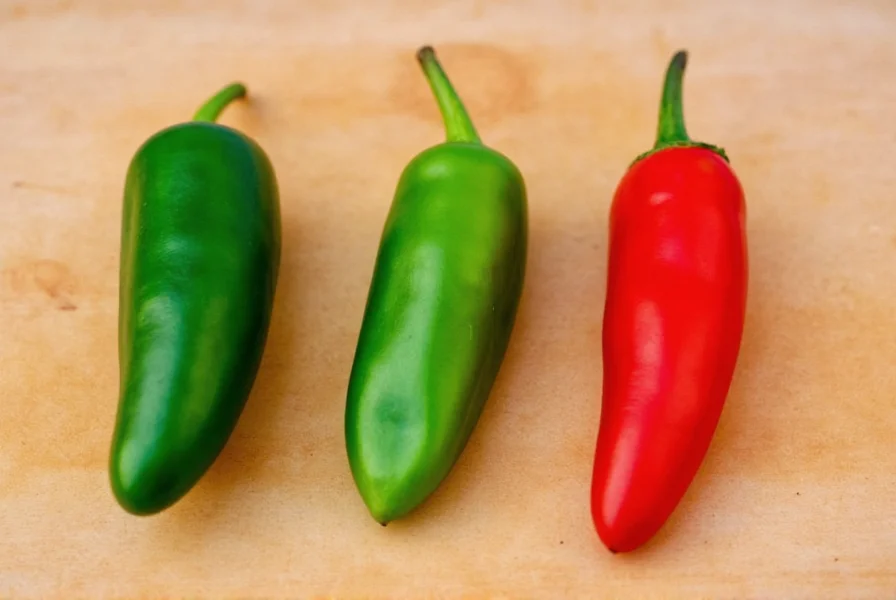When your recipe calls for Fresno chilies but you can't find them, knowing the right substitute makes all the difference in your cooking. These vibrant red or green chilies offer a unique balance of moderate heat (2,500-10,000 Scoville units) and grassy, slightly fruity flavor that enhances salsas, sauces, and roasted dishes. Understanding proper substitutions ensures your culinary creations maintain their intended flavor profile without compromising quality.
Understanding Fresno Chili Characteristics
Fresno chilies (Capsicum annuum) resemble smaller jalapeños but offer a more complex flavor profile. They typically measure 2-3 inches long with smooth, glossy skin that ripens from green to bright red. Their heat level sits between jalapeños and serranos, making them versatile for various dishes. The green variety provides a grassier taste, while red Fresnos develop sweeter, fruitier notes as they mature.
When selecting substitutes, consider three key factors: heat level (Scoville units), flavor profile (earthy, grassy, fruity), and texture (thick-walled for roasting, thinner for sauces). The ideal replacement depends on whether your recipe requires fresh, roasted, or canned chilies.
Top Fresh Fresno Chili Substitutes
For most cooking applications, these fresh peppers serve as excellent Fresno replacements:
| Pepper Variety | Heat Level (Scoville) | Flavor Profile | Best For | Substitution Ratio |
|---|---|---|---|---|
| Jalapeño | 2,500-8,000 | Grassy, bright, slightly vegetal | Salsas, nacho cheese, stuffed peppers | 1:1 (use 1 jalapeño per Fresno) |
| Serrano | 10,000-23,000 | Sharp, bright, more intense heat | Pico de gallo, hot sauces, ceviche | 1 Fresno = ½ serrano (adjust to taste) |
| Anaheim | 500-2,500 | Mild, earthy, slightly sweet | Stews, casseroles, roasted dishes | 1 Fresno = 1½ Anaheim (for mild recipes) |
| Hungarian Wax | 1,000-15,000 | Buttery, mild when yellow, hotter when red | Pickling, roasting, stuffed dishes | Use yellow stage for milder substitute |
Canned and Preserved Alternatives
When your recipe specifically calls for canned or pickled Fresno chilies, consider these alternatives:
- Pickled jalapeños: Provide similar tanginess with comparable heat (drain and chop to match Fresno texture)
- Mild canned green chilies: Found in Mexican food aisles, these offer the right texture for sauces and stews
- Romesco sauce: Contains similar pepper profiles for Mediterranean-inspired dishes
- Pepperoncini: For milder applications requiring vinegar-based preservation
For recipes requiring roasted Fresno chilies, roast your substitute pepper first to develop similar caramelized flavors. Remove seeds and membranes from any substitute to reduce heat while maintaining flavor.
Recipe-Specific Substitution Guidance
Different dishes require tailored approaches when replacing Fresno chilies:
For Salsas and Fresh Dips
Use equal parts jalapeño for green salsas or mix jalapeño with a touch of cayenne for red salsas. The jalapeño's thicker walls provide similar texture to Fresnos when finely diced. For authentic flavor in Fresno chili alternative for salsa recipes, add a squeeze of lime to enhance the grassy notes.
For Creamy Dips and Sauces
When substituting in queso or cream-based sauces, use roasted Anaheim peppers for milder flavor or serranos for more heat. Blend roasted substitutes with cream cheese for the smooth texture characteristic of Fresno-based sauces.
For Stews and Braises
For slow-cooked dishes, Anaheim peppers work best as a substitute for Fresno chilies in recipes requiring long cooking times. Their mild flavor develops beautifully without overwhelming other ingredients. Add toward the end of cooking to preserve freshness.
For Pickled Applications
When making pickled peppers as a Fresno chili vs jalapeño substitution, use a 50/50 mix of jalapeños and banana peppers. The banana peppers provide sweetness while jalapeños contribute heat, mimicking Fresno's balanced profile.

Adjusting for Heat and Flavor Balance
When substituting, always taste as you go. Start with less heat than you think you need—you can always add more, but you can't remove excess heat. For dishes where heat builds over time (like stews), use 25% less substitute initially.
Balance intense heat with dairy (sour cream, cheese), acid (lime juice, vinegar), or sweetness (honey, roasted peppers). These elements help recreate the nuanced flavor profile of Fresnos when using stronger substitutes like serranos.
Professional chefs recommend making a small test batch when trying a new best substitute for Fresno chilies in recipes to ensure proper flavor integration before preparing the entire dish.

Storage and Preparation Tips
Store fresh substitutes like jalapeños in the refrigerator's crisper drawer for up to two weeks. For longer storage, roast and freeze them in airtight containers. When handling hot substitutes like serranos, wear gloves to prevent skin irritation.
Remove seeds and white membranes to reduce heat while preserving flavor. For recipes requiring similar peppers to Fresno chilies, consider roasting any substitute to develop deeper, sweeter notes that better approximate mature red Fresnos.











 浙公网安备
33010002000092号
浙公网安备
33010002000092号 浙B2-20120091-4
浙B2-20120091-4